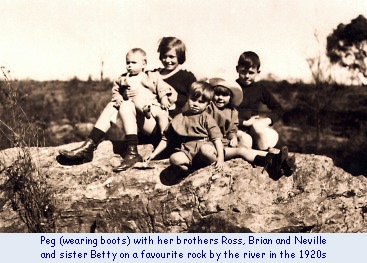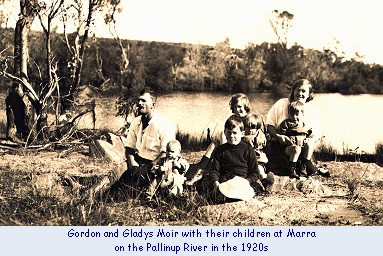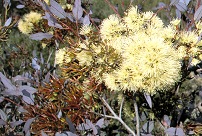 "Noongars lived as I said all along the coast. Some of them were employed by Hassells, Wellsteads, Moirs to shepherd their sheep from Two People Bay right along the coast to Bremer Bay. They were out there ten or twelve months of the year then they'd get them back to the farms close to shearing time. But there were people living there all year around they tell me, these families. And there were others in other locations also that used to go down to shepherding grounds and they never mixed the sheep."
"Noongars lived as I said all along the coast. Some of them were employed by Hassells, Wellsteads, Moirs to shepherd their sheep from Two People Bay right along the coast to Bremer Bay. They were out there ten or twelve months of the year then they'd get them back to the farms close to shearing time. But there were people living there all year around they tell me, these families. And there were others in other locations also that used to go down to shepherding grounds and they never mixed the sheep."
Aden Eades
"Well it was play time mainly with horses with my older brother, who was only a year older, and whatever he did was OK for me to do also. We liked to be sent out mustering sheep during that period. As we had read all of our father's thrilling novels by Zane Grey, we acted out the part as we went looking for the sheep. Suddenly my brother would raise his hand in the halting position and I would whisper, "Why are we stopping" and he would say, "Can't you see that spiral of smoke over the hill there, Indians are there, we better be on the lookout". So then we would get going again and finally find the sheep and take them home.
There were no amenities, as farmers know of them nowadays. There were absolutely no amenities, no water laid on, no self feeders and also sprays for flystrike and things like that I had to manage as well as I could. It was incredible what a person can do when they had to and how to treat sheep when there was fly strike detected in a mob. It was challenging to run them into the shearing shed and pack them into the catching pens the shearers used. That was a solution and then to sharpen up the hand shears and cut off the affected areas on the sheep, big strong wethers. I had to ride them back to front most of the time and cut off the affected areas with hand shears and sponge on a mixture of Cooper's Dip and that acted very well, that was quite effective.
We had dams and they held the water very well `til the late summer and that
presented the biggest problem of all. When the dams, the local dams ran dry
luckily there was a wonderful fresh water soak near the head of the river
where the cottage was. I put all the sheep, no matter if they mixed up the
hoggets with the older wethers, too bad, they all had to go together in that
paddock which was a big and accommodating one feed-wise luckily! Then
every second day I had to take the cattle and the horses to water. Well
horses can be very naughty indeed if anyone attempts to mix them with
cattle. They put up their tails in the air and they prance around the cattle
until they have them in a mood to stampede. So that didn't work, I couldn't
take them together, I had to take them separately, down two and a half miles to water, two and a half miles back and then the cattle the same."
Peg Tyndale Powell
(description of life at Marra as a child in the 1920s and later when Peg managed the farm during the war)
 "Every autumn the mated ewes were walked down to the estuary of the
Pallinup River. They were kept there for about six weeks, taken home before
lambing of course, but this was an important time of their pregnancy and
they went on to excellent natural feed. One of the best feeds available in that
particular locality was a bush that we called `blue bush'. Now you couldn't
get a horse to walk past a `blue bush' and I don't suppose you could get a
cow, but we didn't have any in those days. It was something that attracted
all animals, they thrived on it. It doesn't look blue, each leaf is partly bronze
coloured and the other half is possibly a pale blue, it's got that combination.
It's a low shrub usually, only about this high and spreads out.
"Every autumn the mated ewes were walked down to the estuary of the
Pallinup River. They were kept there for about six weeks, taken home before
lambing of course, but this was an important time of their pregnancy and
they went on to excellent natural feed. One of the best feeds available in that
particular locality was a bush that we called `blue bush'. Now you couldn't
get a horse to walk past a `blue bush' and I don't suppose you could get a
cow, but we didn't have any in those days. It was something that attracted
all animals, they thrived on it. It doesn't look blue, each leaf is partly bronze
coloured and the other half is possibly a pale blue, it's got that combination.
It's a low shrub usually, only about this high and spreads out.
Once the sheep got there they were looked after by two Aboriginal brothers, and of course they were referred to as shepherds. Occasionally my father used to go down and see if everything was ok and that meant that he rode down. In those days you always carried a rifle and he would have lent this particular brother named Roy the rifle and one cartridge to go and get a kangaroo. A change of diet because the rest of their diet would have been rabbits and ducks that they used to trap in the shallow water with rabbit traps, and fish. Now this particular gentleman was a super shot and he had an unusual mannerism about his skill and that was he shot with both eyes open. Have you ever seen anyone shoot with both eyes open? Incredible.
On one occasion, and I really can't remember how it worked out, I was left
to ride the horseback to the homestead from this paddock at night time. My
instruction from dad was let the reins stay loose, keep your knees well behind
the kneepads on the saddle and let the horse take you home. And it did. It
took three to four hours for that to happen. I was scared stiff, I was still in
short pants, I wasn't a teenager even. And of course pitch dark night and
you'd hear a thump, thump, thump and that'd be a kangaroo but you never
knew what was going to leap out of the dark. The occasional dingo would
howl. The owls used to swoop by and the horse would throw its head around
and the bridle would rattle and I'd think what's it going to do, I could hardly
see its head. That horse surely had sharp ears."
Brian Moir
(looking after sheep at Marra)
 "Down here at Hassells, the first year that they had sheep there, in the
autumn the aborigines weren't allowed to carry on their burning program
because that was against Englishman's ideas. The first winter they lost
sheep, they died and that happened again the next year. One of the old
Noongars, how they did it I don't know, he and Bill's (Hassell) ancestor,
grandfather, talked about it and somehow he told Bill's grandfather that it
was the poison in the bush that was killing the sheep. After their burns
there was no poison so he said righto you carry on with your burning program,
and the next year they hardly lost any sheep."
"Down here at Hassells, the first year that they had sheep there, in the
autumn the aborigines weren't allowed to carry on their burning program
because that was against Englishman's ideas. The first winter they lost
sheep, they died and that happened again the next year. One of the old
Noongars, how they did it I don't know, he and Bill's (Hassell) ancestor,
grandfather, talked about it and somehow he told Bill's grandfather that it
was the poison in the bush that was killing the sheep. After their burns
there was no poison so he said righto you carry on with your burning program,
and the next year they hardly lost any sheep."
Jeff Ellett



